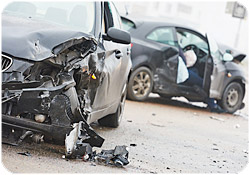Section 2 of the Code defines an offence as “an act or omission which renders a person liable for punishment”. There is an area of offending involving lower level driving offences where persons who are responsible for acts or omissions of a comparable level of seriousness are dealt with differently. This is most likely to occur where there is an omission on the part of a driver to observe a risk real or potential. An inconsistency in charging individuals gives rise to injustice and to persons accused of the more serious offence experiencing a justifiable sense of grievance.
There is an inconsistent application of the discretion to charge at first instance, which derives naturally enough where individual investigating officers exercise a discretion influenced by their own world view, experience and attitudes. More significantly it is also due to the following:
1. The wide definition of the term “operates dangerously”;
2. Section 83 TORUM provides no sanction where there is death or grievous bodily harm is a consequence of the subject driving;
3. The possibility that arresting officers consider the consequences of the offending in determining what section to charge under;
4. The inherent difficulty involved in the concept of “momentary inattention”; and
5. The historical requirement of “fault” as an element of “operating dangerously”.
To minds not steeped in a lifetime’s experience of the criminal law concerns over the distinction may seem minor. However, the chasm between potential penalties involved is not. It would not be unusual for a person sentenced pursuant to section 83 TORUM to be penalised by way of a fine with a traffic conviction, even when a death has resulted from the act or omission which constitutes the offence. When a person is convicted of dangerous operation of a vehicle causing death or grievous bodily harm (“GBH”), even when the subject driving is of a low level, it is not uncommon for a person who has led a blameless life to find him or herself in a position where they will face the almost certain prospect of a term of actual imprisonment. That will be so even if the act or omission was the result of an error in judgement, a mistake or was the unintended but foreseeable consequence of a willed act.
The charge that a person initially faces is within the discretion of the arresting police officer. The vice in the present system is that there are no guidelines as to when a person should be charged with one offence or the other.
 Where momentary inattention results in great harm
Where momentary inattention results in great harm
On 12 December 2014, the Court of Appeal allowed an appeal against conviction in R v Sheldon [2014] QCA 328. The appellant was convicted by a jury in the District Court at Southport of one count of dangerous operation of a vehicle with circumstances of aggravation (causing two deaths and leaving the scene).
The facts of the case read like the script of a Guy Ritchie movie. The appellant and his two passengers were driving away from the IGA store at Mudgeeraba, where they had committed a break and enter. The appellant was driving a late model VW Golf (“the VW”), in which were three persons and a safe weighing some 20 kilograms which had been taken from the IGA store. As the appellant drove along Spencer Road he noticed an odour and enquired of the passenger in the rear seat whether the odour was emanating from the safe.
A prime mover with a B double attached (“the truck”) was parked within the northbound parking lane on Spencer St, (which was a service road to the M1 motorway). The driver of the truck had unloaded the second trailer and was asleep in the sleeping compartment. There was nothing untoward about the way in which the truck was parked; the truck was completely within the parking lane, but parked at a slight angle with “…it’s left hand-front wheels up on the angled kerb and it’s right-hand wheels within the lane marking, apparently further than the rear trailer wheels”.
On the appellant’s version, shortly after making the enquiry about the odour, he felt something heavy hit his shoulder which then slipped onto his lap. He thought that the passenger in the rear had lifted the safe and rested it on the shoulder of the driver’s seat from where it fell onto him. The appellant then took his eyes off the road and used both arms in an attempt to push the safe back into the rear seat.
The VW collided with the rear of the second trailer; both passengers in the VW were killed. The appellant was unconscious for a time, then after exiting the wreckage he went to a house to seek assistance. He then fled the scene.
The jury convicted the appellant of that offence (“the 23 June 2011 offence”) additionally and after verdict the appellant entered a plea of guilty to a further count of dangerous operation of a vehicle causing death (“the 6 June 2009 offence”), with the aggravating circumstances that he was affected by alcohol and, although he knew or ought reasonably to have known that the other man involved in the collision had been killed or injured, he left the scene of the incident.
The appeal was upheld on a direction point concerning section 25 of the Code: extraordinary emergency.
Without going into the merits of the case, on analysis of the manner of operating the vehicle, the following features become evident:
1. There was no allegation of excessive speed;
2. There was no alcohol or other intoxicating substances in the appellant’s body;
3. The VW was sound with no mechanical defects;
4. There was no evidence of skylarking;
5. There was no failure to observe a real or potential risk;
6. There was no evidence of deliberate risk taking in the face of an obvious risk; and
7. There was no heavy concentration of traffic at the time.
Absent the appellant’s poor antecedents and circumstances preceding the subject driving, the case is a potent illustration of the horrendous consequences of a lower level dangerous operation of a vehicle.
Holmes JA succinctly defined the case at paragraph [28]:
[28] It is unnecessary to consider what was advanced as to speed, … It was accepted on the Crown case that the speedometer reading of 98 kilometres per hour might not be reliable; that was the evidence of Mr Ritchie. It was not necessary that the jury, or indeed this Court, be satisfied that the appellant was speeding in order to conclude that he was guilty of dangerous operation of a motor vehicle. Permitting a vehicle to move out of a driving lane and into the back of a parked truck could properly be found to amount to dangerous operation; the possibility that it involved only a momentary lapse in attention would not preclude that conclusion. (footnotes omitted)
 What is driving without due care and attention?
What is driving without due care and attention?
There is very little authority to assist in divining where the divide between dangerous operation of a vehicle and driving without due care and attention lies.
In Johannsen —v- Zeller Ex Parte Zeller [1958] Qd R 366, Stanley J held at 371:
In Simpson v Peat [1952] 1All E.R. 447 the Court interpreted the words “due care and attention” to mean that the question for the Justices was — “Was the defendant exercising that degree of care and attention that a prudent driver would exercise in the circumstances?”. In my opinion it must not be forgotten that the relevant circumstances are in part created by the defendant driver; and the lack of “due care and attention” may not have amounted to negligence towards another person but may have been a failure to exercise the degree of care and attention that a reasonable and prudent driver would have exercised in looking after his own safety.
Johannsen was followed in Butler v Livett; ex Parte Livett [1969] QWN 43 where the Full Court held that a car veering onto the incorrect side of the road was not sufficient to amount to driving without due care and attention in circumstances where the Crown could not negative the defendant’s evidence that he was forced onto the wrong side of the road by an oncoming car.
That decision was considered and followed by Judge BM McLoughlin in Cooper v Shorten (1976) 4 QL 317, where the court held that performing “doughnuts” in a park did not amount to driving without due care and attention. His Honour held after an analysis of the authorities including Johannsen and Levitt:
…..it is not sufficient to justify a conviction for the offence to show that the vehicle behaved in a manner differently from that of a vehicle conforming to the normal pattern of behaviour on the road or place where it may be. It is necessary for the prosecution to establish that in the circumstances of the case there was a duty of care and attention on the accused and that he by his manner of driving did not conform to that standard of care and attention.
McLoughlin DCJ was considering section 17 of the Traffic Act 1949 (Qld), which was in essentially the same terms as section 83 TORUM.
White J of the South Australian Supreme Court in Police (SA) v Melisi [2010] 55 MVR 84 held:
[17] The legal principles applicable to alleged contraventions of the obligation to drive with due care are well established. The issue is to be determined objectively. The obligation to drive with due care is a duty to exercise the standard of care which one would expect of a reasonably prudent driver in the like or similar circumstances. In the assessment of whether a particular driver has departed from that standard, it is immaterial that he or she had been unaware of, or did not avert to, the risks which the manner of driving presented to other road users. The reasonably prudent driver is expected to drive with a defensive outlook, that is, a lookout “that not only sees immediate, or immediately developing, danger, but looks well ahead and searches for potential danger.
It seems that the line between dangerous operation and driving without due care and attention has always been unclear. The older authorities contemplated that the charge of driving without due care and attention involved a duty of care to another and some negligence.
It is axiomatic that not every motor vehicle collision results in a charge of dangerous operation of a vehicle. Similarly, not in every case where there is a failure to observe a real or potential risk will an offence of either dangerous operation or driving without due care and attention be made out. The reality is that more often than not the subject driving will only come to the attention of the investigating authorities when there is a motor vehicle incident. In the absence of guidelines or a system of oversight, it is difficult to exclude the suspicion that in some cases when a person is charged with Dangerous operation of a vehicle causing death or GBH the consequences of the subject driving has been taken into account.
 What is momentary inattention?
What is momentary inattention?
It is clear that an offence of dangerous operation can be made out where the danger to other road users is the result of momentary inattention. There is a distinction between an incident of momentary inattention and the consequence of it. While momentary inattention is a failure to pay due care and attention, the dangerousness derives from the manner of driving e.g. drifting out of a lane.
This situation is different from a case where a person fails to observe a real or potential risk. R v Wilson [2009] 1 Qd R 476 was a case where a motorcycle rider commenced an overtaking manoeuvre on the Bruce Highway near Cardwell. He failed to observe an oncoming motorcycle and collided with it. The failure to see the oncoming motorcycle was an error which lead to the driver undertaking a manoeuvre which would normally not have been dangerous. Such an error is not momentary inattention.
However, the rider of the oncoming motorcycle was killed, Wilson’s pillion passenger sustained GBH and Wilson suffered serious life threatening injuries.
McBride v The Queen (1965-66) 115 CLR 44 was another case involving a failure to observe a risk. It was an application to the High Court seeking special leave. The applicant was a truck driver who was convicted of an offence against Section 52A of the Crimes Act 1900 (NSW). The applicant was driving a truck along a main road in a Sydney suburb. He was following a vehicle, which stopped; he then swerved to go around the vehicle and collided with a woman and her infant son on a pedestrian crossing. The child was killed and the woman sustained serious injuries. There was evidence that the brakes on the vehicle were defective. However, the applicant maintained that he did not see the pedestrians because they had “stepped out from behind” another vehicle entering the intersection.
Barwick CJ held at page 51-52:
However, in the present case, the only basis which the evidence offered for concluding that the motor vehicle was being driven in a manner dangerous to the public was that it was being driven so inattentively when approaching the pedestrian crossing that such inattentive driving constituted a danger to the public. And as I have said the only evidence that the motor vehicle was being driven inattentively were the circumstances of the impact and the accused’s account of the happening.
Barwick CJ had found that “…this quality of being dangerous to the public in the speed or manner of driving does not depend upon the resultant damage….Whilst the immediate result of the driving may be inferred, it is not that result which gives it that quality.”
The concept of momentary attention has concerned the courts from an early time.
Up until Wilson juries in Queensland were regularly instructed that “fault” was an element of the offence of dangerous operation.
Our present understanding of what amounts to dangerous operation of a vehicle was shaped by the cases where fault was considered an element of the offence and other cases where the subject driving was due to momentary inattention.
It is useful to look at the development of the Law.
Section 328A of the Criminal Code came into being when it was amended by section 9 of the Criminal Code Amendment Act 1943.
The offence was created in the following terms:
If any person drives a motor vehicle on a road recklessly or at a speed or in a manner which is dangerous to the public, having regard to all the circumstances of the case, including the nature, condition, and use of the road and the amount of traffic which is actually at the time, or which might reasonably be expected on the road.
The starting point to any discussion as to what amounts to driving in a manner dangerous to the public is The King v Coventry (1938) 59 CLR 633, where the High Court refused to grant the Crown special leave to appeal from the Court of Criminal Appeal in South Australia. That Court had quashed a conviction of an offence of driving a motor vehicle in a manner dangerous to the public and thereby causing death. Latham CJ, Rich, Dixon and McTiernan JJ held:
The driver may have honestly believed that he was driving very carefully, and yet may be guilty of driving in a manner which is dangerous to the public. The jury is to determine, not whether the accused was in fact, as a matter of psychology, indifferent or not to the public safety, but whether he has driven in a manner which was dangerous to the public. The standard is an objective standard, “impersonal and universal, fixed in relation to the safety of other users of the highway”. … The standard is impersonal in the sense that it does not vary with individuals, and it is universal in the sense that it is applicable in the case of all persons who drive motor vehicles.
The judgement needs to be read in the context of the South Australian legislation:
The section is a long one, comprising four sub-sections, all of which should be considered to obtain a full appreciation of its effect, but the words actually creating the offence or offences are relatively few. They are as follows: “Any person whoâ(a) drives a motor vehicle in a culpably negligent manner, or recklessly, or at a speed, or in a manner, which is dangerous to the public; and (b) by such negligence, recklessness, or other conduct, causes the death of any person, shall be guilty of a misdemeanour.
Interestingly, in Coventry the High Court addressed what we understand as momentary inattention. The South Australian Court had held:
“We think that a manner of driving involves more than a casual or transitory act or omission. It involves a course of conduct although not necessarily for any considerable period. The failure to give a signal, or to sound a warning, could hardly be described as a manner of driving.”
The High Court specifically rejected that proposition.
It is, in our opinion, wrong to exclude an act or omission from “manner of driving” because it is casual or transitory in some senses in which these somewhat flexible words may be understood. Such an exclusion may even suggest that carelessness or inattention may constitute a defence to a charge under the relevant provision of the section. Sudden, even though mistaken, action in a critical situation may not, in all the circumstances of a case, constitute driving to the danger of the public. But casual behaviour on the roads and momentary lapses of attention, if they result in danger to the public, are not outside the prohibition of that provision merely because they are casual or momentary. Further, “manner of driving” includes, in our opinion, all matters connected with the management and control of a car by a driver when it is being driven. It includes starting and stopping, signalling or failing to signal, and sounding a warning or failing to sound a warning, as well as other matters affecting the speed at which and the course in which the car is driven.
It is clear that “fault” played no part in the Court’s reasoning in Coventry. To find fault as is so often is the case we need to look to England.
Fault
In R v Evans [1963] 1 QB 412 the appellant applied for leave to appeal against his conviction of causing death by dangerous driving pursuant to Section 1(1) of the Road Traffic Act 1960 (U.K.). The appellant was described by the court as a “very experienced driver with a very long and good record behind him driving his Jaguar motor car along a straight open road”. He passed a vehicle being driven at about 40 miles per hour, and collided with an oncoming vehicle killing its driver. The appellant’s explanation for failing to see the oncoming vehicle was ”…that there was a dip in the road ahead of him and at the vital moment when he was deciding to overtake and commenced to overtake, the approaching vehicle was hidden in that dip, but he knew the dip was there and he was apparently taking a chance”. After a trial Mr Evans was fined 150 pounds and disqualified from holding a drivers licence for three years.
Fenton Atkinson J described the complaint in the following terms:
The real criticism advanced by counsel for the appellant, as I now understand it, is that the summing-up is open to the construction that, if a man through the slightest fault on his part has an accident and somebody unfortunately has been killed, then danger has in fact resulted from his driving and, therefore, he must necessarily be guilty of causing death by dangerous driving. That, in the judgement of the court, does not follow at all. There is really nothing in the summing up, to lead the jury to suppose that, merely because an accident had happened and somebody has been killed, danger had in that sense arisen, and, therefore, it must follow that the appellant was driving in a manner dangerous to the public.
The appeal was dismissed.
In R v Bell and Loughlin (1966) Cr App R 266 the Court of Criminal Appeal followed Evans. The facts in this case are as follows. The two appellants were civilians working for the Territorial Army. They were driving a ferret scout car near Shrewsbury. The driver of a ferret scout car had limited visibility, which is restricted to about 80° to the front. There was limited vision to the sides of the vehicle and none to the rear. The driver of the vehicle relied upon the commander, who stood in the turret of the scout car and gave directions via intercom.
Ball was the driver of the vehicle. At about 3:45 p.m. on 17 September 1965, he approached an intersection with the A5 (a major highway). As the scout car approached the intersection Ball halted the vehicle and then, acting upon the instructions of Loughlin, entered into the intersection.
A motorcycle was approaching and collided with the scout car; the rider was killed. Ball was charged with Causing death by dangerous driving and Loughlin was charged with Aiding and abetting in the commission of the offence. Both men were convicted. Ball was granted an absolute discharge, and Loughlin was fined £25 and disqualified from holding or obtaining a drivers licence for a period.
At first instance, the trial judge directed the jury, in terms of the judgement of the court in Evans. The Court of Criminal Appeal, which included Fenton Atkinson J held:
It is, in the opinion of this court, perfectly clear that what is meant by “driving in a manner dangerous” is the manner of the actual driving, which in this case was coming out of a minor road across a major road. It has been held time and again that an offence under this section is an absolute offence, not a question of the driver being vicariously liable for somebody else’s action, but it is a liability on the driver which he cannot get rid of, and if the result of his driving produced what the jury considered to be a dangerous situation, a dangerous manoeuvre, then even though he had been completely blameless, he can be held liable.
And further that “ …the case of Evans now sets out quite clearly that the test is a purely objective one and that it matters not why the dangerous situation was caused or the dangerous manoeuvre executed”. The purely objective test in Evans and Bell and Loughlin was not consistent with the test the High Court set in Coventry.
In 1964, Section 328A of the Queensland Criminal Code was amended by Section 6 of Act No 14 — to insert the words: “if the offender causes the death of or grievous bodily harm to another person, he is liable upon conviction upon indictment to imprisonment with hard labour for five years.”
The English Court of Appeal rejected the purely objective test in Evans and the proposition that dangerous driving was an absolute offence in R v Gosney [1971] 2 QB 674. Mrs Doreen Gosney was observed at about midnight on 28 March 1970 by two police officers to be driving along a one way part of the A2 in the wrong direction at about 30 mph.
Her version was that she was unfamiliar with the road and that there were no signs or indications that the right turn she conducted was not permitted nor was there any sign to indicate that she was in fact going the wrong way.
The trial judge excluded the evidence she sought to lead, quoting in his reasons the judgements in both Evans and Ball and Loughlin. Megaw LJ, delivering the judgement of the Court of Appeal, specifically overruled the proposition that dangerous driving was an absolute offence.
We would state briefly, what in our judgement the law was and is on this question of fault in the offence of driving in a dangerous manner. It is not an absolute offence. In order to justify a conviction there must be, not only a situation which, viewed objectively, was dangerous, but there must also have been some fault on the part of the driver, causing the situation. “Fault” certainly does not necessarily involve deliberate misconduct or recklessness or intention to drive in a manner inconsistent with the proper standards of driving. Nor does fault necessarily involve moral blame. Thus there is fault if an inexperienced or naturally poor driver, while straining every nerve to do the right thing, falls below the standard of a competent and careful driver. Fault involves a failure; a falling below the care or skill of a competent and experienced driver, in relation to the manner of the driving and to the relevant circumstances of the case. A fault in that sense, even though it might be slight, even though it be a momentary lapse, even though normally no danger would have arisen from it, is sufficient. The fault need not be the sole cause of the dangerous situation. It is enough, if it is, looked at, sensibly, a cause. Such a fault will often be sufficiently proved as an inference from the very facts of the situation. But if a driver seeks to avoid that inference by proving some special fact, relevant to the question of fault in this sense, he may not be precluded from seeking to do so.
The notion of fault derives from a rejection of the proposition that driving in a manner dangerous to the public was an absolute offence. Although offences in Queensland were never “absolute offences”, fault was adopted.
The Queensland Court of Criminal Appeal in R v Webb [1986] 2 Qd R 446 confirmed a two-step approach involved in determining whether a driver should be convicted of dangerous driving which included some measure of fault on the part of the accused.
Maxine Webb was convicted in the Magistrates Court at Gladstone of dangerous operation simpliciter.
The charge of dangerous driving arose out of a collision between a motor car being driven by the applicant and another being driven by a man named Lewis, which occurred on Benaraby Road, Gladstone at about 6:30 p.m. on July 2, 1984. The collision occurred on what the magistrate described as a relatively straight section of highway, though there was a curve to the left in the applicant’s direction of travel. It was open road, and a speed limit of 100 km per hour.
Ms Webb’s version was that she was blinded by the headlights of the oncoming vehicle and that it was over the centre line. The Magistrate specifically rejected her version of events. At trial Ms Webb relied upon Section 25 of the Criminal Code: extraordinary emergency. Williams J delivered the leading judgement:
There are two steps involved in determining that a driver should be convicted of dangerous driving. Firstly, the driving (that is what actually occurred) must be considered objectively by the tribunal of fact and be held to be dangerous. Secondly, there must be some fault on the part of the driver which caused a danger to the public.
His Honour specifically rejected the notion that something more than “an error of judgement” was required before either question could be decided against the driver. His Honour adopted the statement of the High Court in Coventry and adopted the formula of words in Evans:
It is quite clear from the reported cases of that, if a man in fact adopts a manner of driving which the jury think is dangerous to other road users in all the circumstances, then on the issue of guilt, it matters not whether he was deliberately reckless, careless, momentarily inattentive or doing his incompetent best.
The notion of “fault” had an effect upon our understanding of what amounts to dangerous operation up until The Queen v Jiminez (1992) 173 CLR 572. It seems that in lower level driving incidents there was a tendency of investigators to ‘reverse engineer’. In a situation where there was a collision and the accused’s version was that they did not see the object they collided with. There was a tendency to find fault in a failure to pay due care and attention.
However Jimenez changed all that, it concerned the offence of culpable driving pursuant to Section 52A of the Crimes Act 1900 (NSW). The appellant was driving from the Gold Coast to Sydney on the 13th of June 1988. He had slept for about four hours the previous afternoon. The passengers in the vehicle rotated driving. He slept further in the car. At about 3:30 a.m. the applicant took over the driving until approximately 6 a.m. when there was a single vehicle incident whereby the motor vehicle left the road and collided with trees. A passenger was killed.
On the appellant’s version he had fallen asleep without any notice. In dealing with the New South Wales legislation, the High Court held:
The manner of driving encompasses “all matters connected with the management and control of a car by a driver when it is being driven”. For the driving to be dangerous for the purposes of section 52A, there must be some feature, which is identified not as a want of care, but which subjects the public to some risk over and above that ordinarily associated with the driving of a motor vehicle, including driving by persons who may, on occasions, drive with less than due care and attention. Although a course of conduct is involved, it need not take place over any considerable period. Nor need the conduct manifest itself in the physical behaviour of the vehicle. If the driver is in a condition while driving, which makes the mere fact of his driving a real danger that the public, including the occupants of the motor vehicle, then his driving in that condition constitutes driving in a manner dangerous to the public. In the same way, driving a motor vehicle in a seriously defective condition may constitute driving in a manner dangerous to the public, even though the defect does not manifests itself until such time as the vehicle is out of the control of the driver. But it should be emphasised, and it must always be brought to the attention of the jury, that the condition of a driver must amount to something other than lack of due care before it can support a finding of driving in a manner dangerous to the public. Driving in that condition must constitute a real danger to the public. As Barwick CJ said in McBride v The Queen:
‘ the section speaks of a speed or manner which is dangerous to the public. This imports a quality in the speed or manner of driving, which even intrinsically in all the circumstances, or because of the particular circumstances surrounding the driving, is in a real sense potentially dangerous to a human being or human beings, who is a member or members of the public may be upon or in the vicinity of the roadway on which the driving is taking place’.
The court, constituted by Mason CJ, Brennan, Deane, Dawson, Toohey and Gaudron JJ specifically considered the issue of fault and held:
“… to our eyes what the appellant was attempting to do in Gosney was to establish an honest and reasonable mistake, a defence which, in this country, makes it unnecessary to introduce fault as an element of that offence. Driving in a manner dangerous to the public is at once both the offence and if it is relevant, the fault, but it will be a defence to establish an honest and reasonable mistake as to facts, which if true would exculpate the driver.”
In Wilson the Court of Appeal’s principal focus was on the misdirection on Section 24, however, the Court did address the question of fault as an element of the offence. The President held:
Although Jiminez concerned the common law defence of mistake of fact, s 24 Criminal Code is considered to accurately reflect the common law: Thomas v The King, recently affirmed in CTM v The Queen. In so far as Jiminez and Webb may be inconsistent, this Court is plainly bound by the High Court’s decision in Jiminez.
 Conclusion
Conclusion
Identifying were Driving without due care and attention ends and Dangerous operations starts is remarkably difficult. However in cases where there is an omission i.e. a failure to observe a real or potential risk, then plainly the gravamen of the offending is a failure to pay due care and attention. When a driver undertakes a manoeuvre oblivious to a risk, the usual criticism is “they should have seen the risk”. The answer to that is, if they had seen the risk they would not have continued with the manoeuvre.
At this point it is perhaps it is worth considering the sentence following the oft-quoted passage in Evans:
It is quite clear from the reported cases that, if a man in fact adopts a manner of driving which the jury think was dangerous to other road users in all the circumstances, then on the issue of guilt it matters not whether he was deliberately reckless, careless, momentarily inattentive or even doing his incompetent best. It is highly relevant, if it ever comes to sentence, and equally relevant in the mind of any person who has to consider whether a prosecution is justified or not.
In order to achieve uniformity in the exercise of discretion there needs to be a policy direction. Section 11 of the Director of Public Prosecutions Act 1984 (Qld), empowers the Director of Public Prosecutions to furnish guidelines to the Commissioner of the Police Service with respect to prosecutions in respect of offences. In order to achieve a consistency throughout the state a guideline could be set recognising that it is preferable for a person be charged with an offence pursuant to section 83 TORUM where the prosecution case is based upon a failure to observe a real or potential risk.
Anthony W Collins
Footnotes




 Where momentary inattention results in great harm
Where momentary inattention results in great harm What is driving without due care and attention?
What is driving without due care and attention? What is momentary inattention?
What is momentary inattention? Conclusion
Conclusion